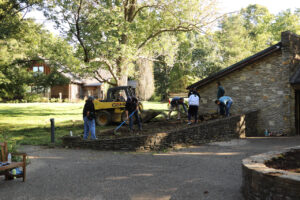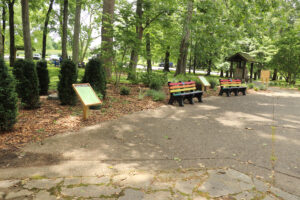
“The mere act of making a garden implies a future in which plants will reach fruition and results will be enjoyed. Gardening is inherently hopeful as a series of affirmative, assertive acts—the seeds will germinate, the plants will enjoy adequate rain and sunshine…and we will survive to see all that.” –KENNETH HELPHAND, DEFIANT GARDENS
Creating a garden isn’t something we should wait for the best of times to start doing – in fact, difficult times are exactly when we should be defying despair by making gardens. We need the optimism so inherent to gardening: the act of enclosing a space and patiently, lovingly cultivating life in it implies endurance, hope, faith, care, a sense of community and the will to be the best possible version of ourselves. A garden meets us where we are and accepts us for who we are.

Any built environment requires maintenance and renovations to stay with the original intent. Bernheim recognized that the existing Sensory Garden was in desperate need of renovation. It would be easy to build back as it was, but Bernheim chose to invigorate the Sensory Garden instead of renovating. Growth at Bernheim transcends growing and maintaining unique tree species in our 620-acre arboretum. Bernheim’s mission of connecting people with nature includes an obligation to provide diversity, inclusion, and accessibility for all species — plant, animal, and human. That was the spirit that guided Bernheim’s team in creating the Sensory Garden, a revitalization of an existing beautiful space of stone beds near the Education Center and the Silos. The garden may be located at Bernheim, but its realization is the product of many throughout the wider community — particularly those who live with Autism Spectrum Disorder or blindness and visual impairment — and their families, caregivers, and teachers.
Staying true to our founder’s vision of a place that truly welcomes everyone is a mission that never ends — and one that requires a lot of listening. Over the course of the garden’s design and realization, the team hosted many visits from the communities of Families for Effective Autism Treatment (FEAT), Dreams with Wings, Arts for All, and the Kentucky School for the Blind, which also provided some of the project’s funding along with the Crusade for Children and Kosair Charities. Their thoughtful insights helped shape the garden’s overall design, signage, special features, navigability and many other aspects, and we’re grateful for their time and support.
In meeting with our partners, the Bernheim team listened and asked questions to truly understand how individuals with Autism Spectrum Disorder and visual impairments use and navigate spaces. We quickly realized that we all connect with nature in the same way: through our senses. With that understanding, we incorporated an amplified sensory design to help those with sensory challenges experience the Bernheim Sensory Garden more independently as they connect to nature. We’ve included the following features:

- Interpretive signage including pictograph and Braille components to describe each sensory landscape bed, the quiet space, and overall purpose of the space. Tree identification signs with Braillecan be found in the picnic area adjacent to the Smell and Quiet spaces.
- Plants with tactile qualities in the Touch space. Some plants represented are lamb’s ear, coneflower, sensitive fern, hops, and variegated yucca. Other tactile elements include smooth driftwood from the Falls of the Ohio, bumpy and rough-textured planter pots, and many upcycled components yet to be installed.

- Quiet Space. In speaking with our partners, we learned that the infinity symbol was the original Autism symbol. We repurposed two millstones that we found on site and used those as individual seats. We planted Taxus cuspidata ‘Columnaris’, commonly known as Adam’s columnar yew, in the shape of an infinity symbol, leaving two openings on opposite sides of the symbol so those who need a quiet space can enter, have a seat, and be soothed while surrounded by nature.
- Sound features. A decorative water feature provides a summer water source for birds and small mammals. The Hearing space will focus on water, but the entire garden sings the song of nature, including insects buzzing, leaves rustling, melodies of wind chimes, and children’s laughter.

- Seating with meaning. The Buddy Benches are the dream of a Cub Scoutwho wants those who have been bullied or are perceived as “different” to have a safe place to take a break from those negative feelings.

With its opening this spring, the garden is still in its infancy — a garden is a process, not a product — and we know our work isn’t done. We hope to continue to add new features like poetry, art installations, and many other items that make it a welcoming, vibrant, engaging, calming, and fun space for everyone who visits. And we hope you’ll come and stay awhile.

